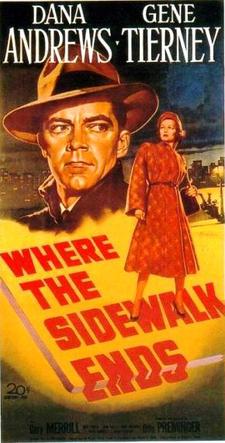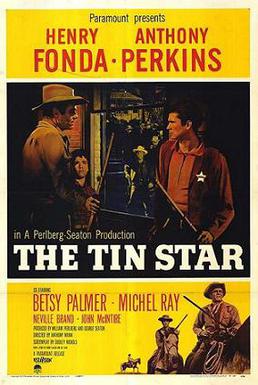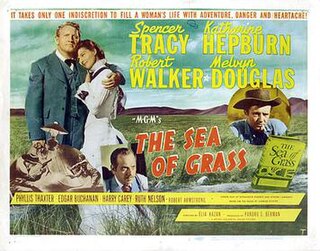
Secrets is a 1933 American pre-Code Western film directed by Frank Borzage and starring Mary Pickford in her last film role. The film is a remake of Secrets (1924), a silent film starring Norma Talmadge, which was based on a 1922 play of the same name.

Where the Sidewalk Ends is a 1950 American film noir directed and produced by Otto Preminger. The screenplay for the film was written by Ben Hecht, and adapted by Robert E. Kent, Frank P. Rosenberg, and Victor Trivas. The screenplay and adaptations were based on the novel Night Cry by William L. Stuart. The film stars Dana Andrews and Gene Tierney.

The Vagabond is a 1916 American silent romantic comedy film by Charlie Chaplin and his third film with Mutual Films. Released to theaters on July 10, 1916, it co-starred Edna Purviance, Eric Campbell, Leo White and Lloyd Bacon. This film echoed Chaplin's work on The Tramp, with more drama and pathos mixed in with the comedy.

The Tin Star is a 1957 American Western film based on a short story, directed in VistaVision by Anthony Mann and starring Henry Fonda and Anthony Perkins, in one of Perkins' first roles. The film became one of the few low-budget westerns to be nominated for the Oscar for Best Writing, Story or Screenplay. Since its release, the film has become one of the classics of the genre. The supporting cast features Betsy Palmer, Neville Brand, John McIntire and Lee Van Cleef.

'Neath the Arizona Skies is a 1934 Western film directed by Harry L. Fraser, produced by Lone Star Productions, released by Monogram Pictures and starring John Wayne. Wayne's character attempts to locate a little girl's father, so that she may claim a $50,000 Indian oil claim. The film co-stars Sheila Terry and Shirley Jean Rickert. George "Gabby" Hayes played a featured character with a speaking role, but his name was omitted from the cast list in the opening credits.

Miss Potter is a 2006 biographical drama film directed by Chris Noonan. It is based on the life of children's author and illustrator Beatrix Potter, and combines stories from her own life with animated sequences featuring characters from her stories, such as Peter Rabbit. Scripted by Richard Maltby Jr., the director of the Tony Award-winning Broadway revue, Fosse, the film stars Renée Zellweger in the title role, Ewan McGregor as her publisher and fiancé, Norman Warne, and Lloyd Owen as solicitor William Heelis. Emily Watson stars as Warne's sister, Millie. Lucy Boynton also stars as the young Beatrix Potter and Justin McDonald appears as the young William Heelis. It was filmed in St. Peter's Square Hammersmith, Cecil Court, Osterley Park, Covent Garden, the Isle of Man, Scotland and the Lake District.

Look to the Lady is a crime novel by Margery Allingham, first published in January 1931, in the United Kingdom by Jarrolds Publishing, London, and in the United States by Doubleday, Doran, New York, as The Gyrth Chalice Mystery. It is the third novel featuring the mysterious Albert Campion, accompanied by his butler/valet/bodyguard Magersfontein Lugg.

Margaret Mann, was a Scottish-American actress.

Has Anybody Seen My Gal? is a 1952 American comedy film distributed by Universal-International, directed by Douglas Sirk, and stars Piper Laurie, Rock Hudson, Charles Coburn, and Gigi Perreau. It is loosely based upon the Eleanor Porter novel ,"Oh Money! Money!". Set in the 1920s, the film leans heavily on period detail, such as flappers, the Charleston and raccoon coats. It is named for the jazz song "Has Anybody Seen My Gal?" which was a hit for The California Ramblers during the '20s. Though the song is sung during the movie, its lyrics have no particular relation to the plot.

Tess of the Storm Country is a 1922 silent film starring Mary Pickford, directed by John S. Robertson, and based upon a Grace Miller White novel. It is a remake of Pickford's film from eight years prior and was subsequently remade a decade later as a sound version starring Janet Gaynor.

The Sea of Grass is a 1947 American Western film set in the American Southwest. It was directed by Elia Kazan and based on the 1936 novel of the same name by Conrad Richter. The film stars Katharine Hepburn, Spencer Tracy, and Melvyn Douglas.
The Cowboy and the Lady is a 1938 American Western romantic comedy film directed by H.C. Potter, and starring Gary Cooper and Merle Oberon. Written by S.N. Behrman and Sonya Levien, based on a story by Frank R. Adams and veteran film director Leo McCarey, the film is about a beautiful socialite masquerading as a maid who becomes involved with an unpretentious, plain-spoken cowboy who is unaware of her true identity. The Cowboy and the Lady won an Academy Award for Sound Recording, and was nominated for Original Score and Original Song.

An Eastern Westerner is a 1920 American silent Western comedy film featuring Harold Lloyd. A copy of the film exists.

The Little American is a 1917 American silent romantic war drama film directed by Cecil B. DeMille. The film stars Mary Pickford as an American woman who is in love with both a German soldier and a French soldier during World War I. A print of the film is housed at the UCLA Film and Television Archive and has been released on DVD.

The Princess and the Pirate is a 1944 American comedy film directed by David Butler and starring Bob Hope and Virginia Mayo. Based on a story by Sy Bartlett, the film is about a princess who travels incognito to elope with her true love instead of marrying the man to whom she is betrothed. On the high seas, her ship is attacked by pirates who plan to kidnap her and hold her for ransom, unaware that she will be rescued by the unlikeliest of knights errant. Produced by Samuel Goldwyn, The Princess and the Pirate received Academy Award nominations for Best Art Direction and Best Music Score.

My Best Girl is a 1927 American silent romantic comedy film directed by Sam Taylor starring Mary Pickford and Charles "Buddy" Rogers that was produced by Pickford. Rogers later married Pickford. Charles Rosher received an Academy Award nomination for his cinematography of this film in 1928. The film is extant and was screened at the Eastman Museum in 2015.

Dorothy Vernon of Haddon Hall is a 1924 American silent historical drama film directed by Marshall Neilan and starring Mary Pickford. The script by Waldemar Young was based upon the 1902 novel Dorothy Vernon of Haddon Hall by Charles Major.

The Spanish Dancer is a 1923 American silent costume epic starring Pola Negri as a gypsy fortune teller, Antonio Moreno as a romantic count, and Wallace Beery as the king of Spain. The film was directed by Herbert Brenon and also features a five-year-old Anne Shirley, appearing under the name "Dawn O'Day." The film survives today.
Bowery Champs is a 1944 American film directed by William Beaudine and starring the East Side Kids.

Riders of the Purple Sage is a 1925 American silent Western film directed by Lynn Reynolds and starring Tom Mix, Mabel Ballin, and Warner Oland. Based on the 1912 novel Riders of the Purple Sage by Zane Grey, the film is about a former Texas Ranger who pursues a corrupt lawyer who abducted his married sister and niece. His search leads him to a remote Arizona ranch and the love of a good woman.

















